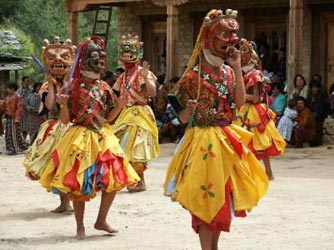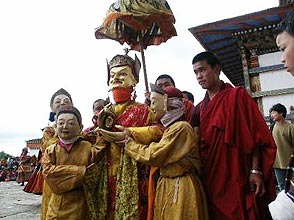 |
|
Festivals
in Bhutan
|
 |
 |
| The
largest annual festival in Bhutan is the Tshechu, an event honoring Guru
Rinpoche through religious dances performed by the monks as well as by
lay people. The dates and duration of the Tshechu festivals vary among
dzongkhags (Districts) but they always fall on or around the 10th day of
the month in the Bhutanese calender.
The
dances are known as Cham and are performed to bless onlookers, to teach
them the Buddhist dharma, to protect them from misfortune and to exorcise
all evil; the dancers who take on the aspects of wrathful and compassionate
deities, heroes, demons, and animals do this. |
|
Zhabdrung Ngawang Namgyal
and Pema Lingpa were main figures who composed many of the dances.
It
is believed that merit is gained by attending this religious festival.
The dances invoke the deities to wipe out misfortunes, increase luck and
grant personal wishes. Onlookers rarely fail to notice the Atsaras or clowns
who move through the crowds mimicking the dancers and performing comic
routines in their mask with long red noses. A group of ladies perform traditional
Bhutanese dances during the intervals between mask dances.
|
An
auspicious event of the many of the Tshechus is the unfurling of the Thongdrol
from the main building overlooking the dance area. This is done before
sunrise and most people rush to witness the moment. Thongdrols are large
Thangkas or religious pictures that are usually embroidered rather than
painted. The word itself means 'liberation on sight.' It is believed that
bad karmas are wiped away simply by viewing it. Apart
from its religious implications, the Tshechu is also an annual social gathering
where people dress in their finest clothing and jewelry.
|
 |
A small fair may
be organized outside the Dzong for those looking for a variety of entertainments.
|




